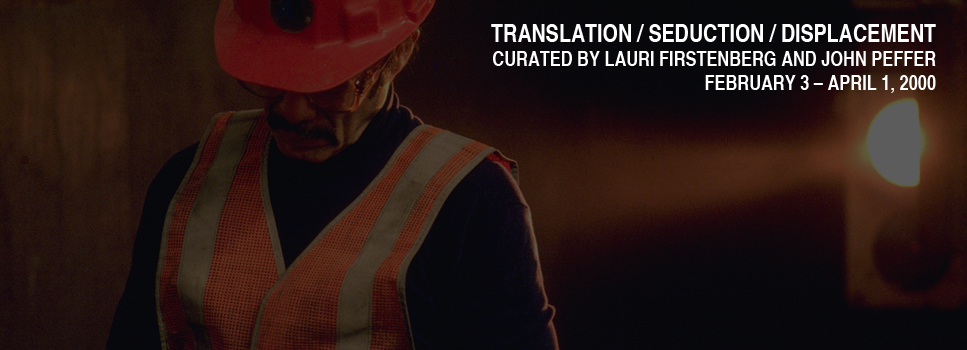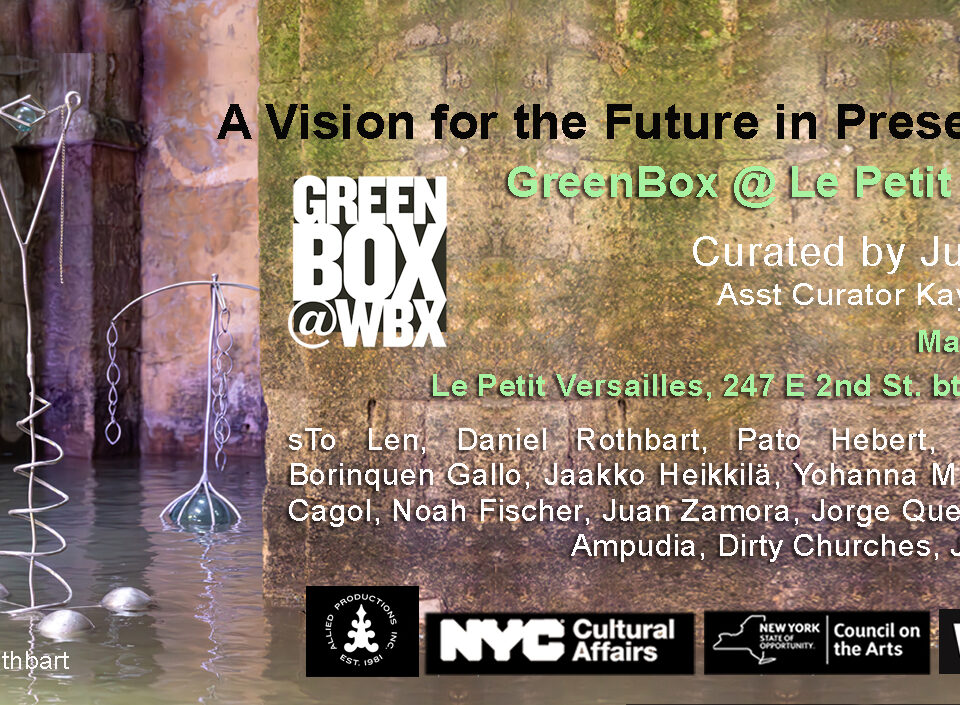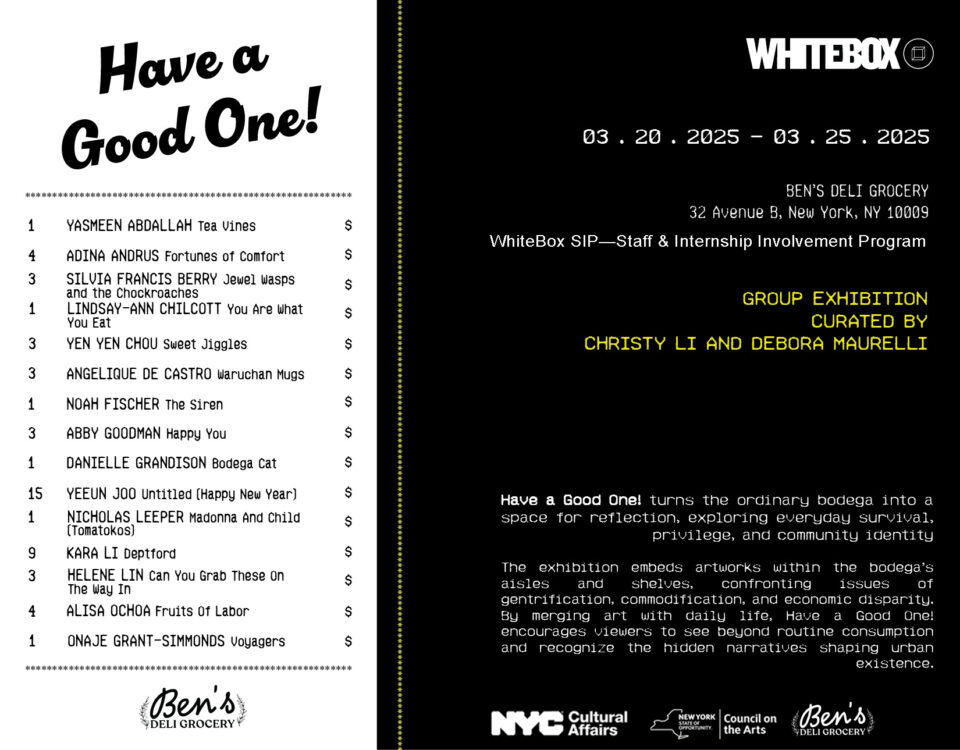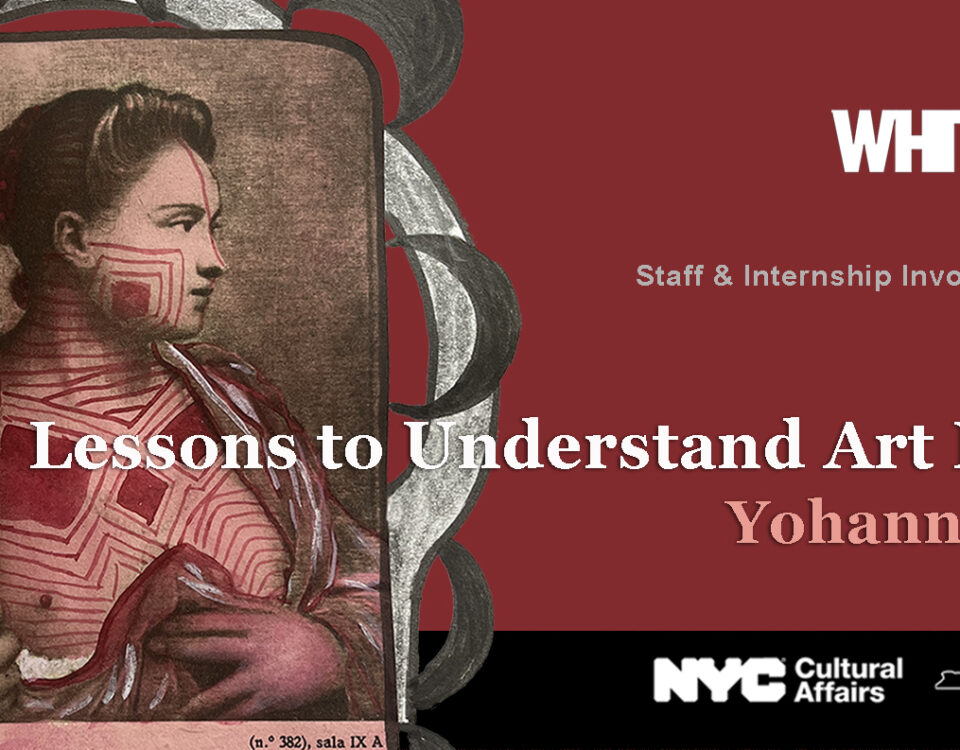GÜNTER BRUS AND HERMANN NITSCH
September 29, 1999TOPOLOGIES
May 4, 2000CURATED BY LAURI FIRSTENBERG AND JOHN PEFFER FEBRUARY 3 – APRIL 1, 2000
Translation/Seduction/Displacement, a group show of artists from South Africa, marks a distinct break from recent survey museum exhibits based on the broad category “Contemporary South African Art”. The artists represented in this exhibition reflect two generations of contemporary artists, working through conceptual and photographic art strategies, who have critically influenced the contemporary art world, both locally and globally.
The concept of the show derives from the various meanings of the word “translation” across several South African languages. For example, in Zulu, “humusha” can mean to interpret, to mislead, or to seduce. In Afrikaans, “vertolking” is translatied as critical or interpretive performance, and “verplaas” contains the idea of translation as physical displacement. The cross-cultural and cross-linguistic operations of translation as “seduction” and “displacement” will frame this exhibition.
The exhibition features the US premier of major work dating to the early 1980s by two internationally prominent artists: photographer Santu Mofokeng (a retrospective of work on tragic 20th century landscapes) and conceptual artist Willem Boshoff (recontextualisations of his visual poetry dating from 1980, titled “Kykafrikaans”). The exhibit traces representational practices related to those of Boshoff and Mofokeng in more recent art by Siemon Allen, Abrie Fourie, Kim Lieberman, Senzeni Marasela, Zwelethu Mthethwa, Rudzani Nemasetoni, Joachim Schonfeldt, Marlaine Tosoni, Andrew Tshabangu, and Hentie van der Merwe.
The exhibition is organized by the following criteria:
Translation—Artists of this group critique representations of violence, and obscure vision. Working in universal conceptual languages overlaid by specific South African polemics, they couch their work in international terms and pose challenges to contemporary art discourse.
Seduction—These artists’ interpretations of history, myth, memory, and sacred belief reroute the spectator’s expectations via manipulations in medium and meaning. What you see is not what you think at first sight, or sound.
Displacement—For these artists a displacement of the historical typing of subjectivity is executed by reconstructing the photographic archive—a revised archive interested in the reconciliation of truth and the inclusion of peripheral identities.
SPONSOR
Fund for Creative Communities New York State Council on the Arts Decentralization Program, administered by the Lower Manhattan Cultural Council
PRESS
Publication: Art Forum
Writer: Nico Israel
Date: 05.00
Title: Translation/Seduction/Displacement
This exhibition of work by contemporary South African artists derived its title from some of the implications of the word “translation” in several of that nation’s languages: translation as libidinal, spiritual, or cartographic displacement and as an act of seduction, enticing, or leading something or someone astray. Gesturing toward the slippages and the communicative potentialities of language, curators Lauri Firstenberg and John Peffer clearly wanted to avoid mounting a regional survey show (“South Africa Now” or “Young South Africans”_ that would claim to be definitive or exoticize practices that are as intimately linked to the rest of the world as is South Africa’s economy. The titular emphasis on language also reflects the Conceptual slant o the work, which is in fact as much about distortion and repulsion as it about translation and seduction.
The curators and the artists they included stressed the tenacious residue of apartheid in the post-apartheid periods and the nuanced complicities between representation, power and history that are nowhere more evident than in South Africa. The exhibition featured the work of twelve artists from two generations, those already known for making art in the late ‘70s and early ‘80s and those working today. The earlier generation’s Willem Boshoff, of Afrikaner origin, and Santu Mofokeng, a Soweto-born black, both produce brilliant work that sometimes overshadows that of their younger “descendents” who showed here. Boshoff’s exquisite book Kykafrikaans (Look Afrikaans), 1977-80, comprised typed visual poems that turned grids and clusters of significant Afrikaans words into twisted knots of meaning. One example is “Verdwaalkaart” (Map to get lost by), 1979, a set of written directions that obscure themselves even as they make up a physical map. Boshoff considers skin, law, and place through the elusive concreteness of language and produces a severe, ethical art that resonates back to Beckett and forward to J.M. Coetzee. Mofokeng was represented by both his older black-and-white photographs and some of his more recent work. “On the Tracks,” a 1994 photographic series, features sweaty men working in dark spaces that one assumes are South Aftrican gold or diamond mines until realizing, from their titles, that the shots were taken in the New York City subway. “Night fall of the Spirit,” 2000, a superb suite of photographs taken over the last few years, depicts the now placid, bucolic landscapes that were once killing fields in Germany, Poland, Vietnam, South Africa, and elsewhere. Skeletons, skulls, memorials, and plaques aside, the blunt truth that Mofokeng confronts is that the land always forgets: It cannot testify to the suffering but bears witness only to a dislocation from its own past.
In the younger generation, among the artists who stood out were Siemon Allen, Rudzaani Nemasetoni, and Hentie van der Merwe. Screen, 2000, Allen’s room-size installation of woven half-inch videotape, created a black, light-absorbing vacuum that dominated the exhibition space. As with Boshoff’s poetry, the viewer senses that something important might be on the tape but cannot decipher it. Nemasetoni’s Litany, 1999, comprised eight altered photographs of the dreaded passbooks and police records that defined “identity” for many South African men. Van der Merwe presented a grid of archival photographs of naked soldiers stationed in German-occupied Southwest Africa (now Namibia) during World War II. Untitled, 1997, already laden with a bizarre blend of homoeroticism and eugenic fascination, could only be viewed through a mirrored contraption, which implicated the viewer as unseen voyeur/participant.
This was a low-gloss, low-budget show, but an important one, whose best works demonstrated that contemporary art in the “new” South Africa is uniquely positioned between a traumatic past that must be reckoned with and a hopeful future that remains to be articulated. In the meantime, these artists, unacknowledged legislators, offer their own interpretations of what “truth” and “reconciliation” might mean.
Publication: Art Net
Writer: Joy Garnett
Date: 03.10.00
Title: Into Africa
Every so often, an ambitious idea takes possession of a modest venue and manages to pack a real punch. In this instance, that venue would be White Box in the Starret-Lehigh Building (611 West 26th) in New York’s Chelsea district, where the traveling exhibition, “Translation/Seduction/Displacement,” is premiering.
Curated by art historians Lauri Firstenberg and John Peffer, this show presents work by two generations of South African artists who use photography and installation to explore classic existential problems—the crisis of the individual in society, for instance, and the inadequacies of language—from a South African perspective.
The exhibition is notable because it looks specifically at the ways that a post-apartheid South African sensibility dovetails with distinctly international and post-conceptual art styles. Taken together, the work is spare, concept-driven and socially critical. While intensely rooted in South African cultural issues, it often reaches beyond the post-apartheid horizon to resonate with international ideas.
The incredible sadness of being
Two longtime veterans of the South African art scene are at the core of “Translation/Seduction/Displacement”—Santu Mofokeng, whose stark, moody images line the walls of White Box’s first and second galleries, and the conceptual artist Willem Boshoff, who specializes in poetic text montages.
Santu Mofokeng’s “Sad Landscapes” is a suite of 20 black and white photographs of places where 20th-century tragedies have occurred. Images of cemeteries and memorials alternate with mute pictures of desert crossroads or a stretch of woods. The photos were made over the past 15 years, and constitute a historical as well as personal pictorial journal.
In a wall text, the artist reflects upon genocide, nature and memory. “how to deal with the memory of the past, “ it asks. “Who can be trusted with this memory?… would a monument invite remembrance, or through a kind of containment, forgetting?:” Mofokeng’s photographs offer a tenuous emptiness where nature has effaced all but the barest traces of horror. It is the desire to forget—or to never forget –that is rendered visible.
It’s startling to then come across Mofokeng’s warmly lit cibachromes in the second gallery, showing men doing track work on the New York subway—out of the jaws of death these soot-smeared workers seem to have arrived, tools brandished, bellies wobbling, lit by the golden glow of the underworld like messengers from Hell.
Beat Poet?
Willem Boshoff is a conceptual artist from Johannesburg who represented South Africa in the 23rd Bienal Internacional de Sao Paulo. He is a collator and dissector of words, preoccupied with the project of human ignorance and the limitations of language. On view at white Box is his project “Kykafriakaans” (1977-80), which takes the form of a book of visual poetry, displayed in a vitrine in a darkened gallery foyer. In this work, Boshoff dissects the language of white nationalism, weaving it into a poetic gibberish of doubtful meanings and dismantled potency.
The Bearded, frowning figure of Boshoff and the etymology-obsessed nature of his work may well conjure the image of an edgy Lawrence Weiner, supplemented by small doses of Jack Kerouac. Past works include Blind Alphabet, a three-dimensional dictionary composed of 338 sculptural units, and The Book That Is Afraid, a protest of South Africa’s once compulsory military service.
The next generation
The younger artists in the show are Siemon Allen (sound pieces; sculpture), Abrie Fourie (slide installation), Kim Lieberman (mixed media, mail art), Senzeni Marasela (photo transfers on cloth), Zwelethu Mthethwa (photo etchings), Rudzani Nemasetoni (photo etchings), Joachim Schonfeldt (video), Marlaine Tosoni (audio CD), Andrew Tshabangu (photographs) and Hentie vand der Merwe (photo installation).
In addition to spareness and conceptual rigor, there is a brooding, messy sadness here, a weird, hypnotic beauty which further unifies the show and pulls you in.
Siemon Allen picks up on the theme of unraveling and re-weaving with a room-filling, black rectangular volume whose opaque walls are densely woven from VHS tape. Muteness and blindness are conflated in one monumental gesture. Though visually as monolithic as Mona Hatoum’s Socle du Monde—a large magnetized steel cube covered with black metal filings—the thinness of Allen’s surfaces belies the cube’s solidity, literally revealing the inherent frailty of architectural exclusion.
Rudzani Memasetoni, originally from Soweto, has lived in new York since 1985. His photo etchings were recently included in “Claiming Art/Reclaiming Space: Post Apartheid Art from South Africa” at the Museum for African Art in Washington, DC. At White Box we are treated to a series of these etchings, which depict blow-ups of that despised object of apartheid-era oppression, the passbook. These particular passbooks belonged to members of Nemasetoni’s family, whose faces stare out stiffly from worn and pitted pages.
Senzeni Marasela is a young Johannesburg-based artist who uses all manner of labor-intensive media, from sand-blasted mirror to photographic transfer onto embroidered calico. Her narrative-based work takes on the events she feels she was shielded from as a child, including images of violent skirmishes and portraits of people who were killed in political struggle. At White Box, her installation of silver tea trays in suspended from the ceiling in a row. Each tray is graced with a silk-screened cloth depicting appropriated images o f struggle and grief, strangely elegant and cathartic.
“Translation/Sedution/Displacement” is up for two months, Feb 4 – Apr 1, 2000, and is punctuated by a rotation of works in early March. A catalogue produced by the Artist Press and Santon Civic Art Gallery, Johannesburg will soon be available.
Publication: New York Times
Writer: Holland Cotter
Date: 03.24.00
Title: Translation/Seduction/Displacement
This group show, organized by Lauri Firstenberg and John Peffer, dips into the wealth of contemporary art being produced in South Africa. Most of the work, by artists of two generations, is post-Conceptual, photographic in form and internationalist in style. Political consciousness runs deep without necessarily declaring itself in polemical terms
The protean photographer Santu Mofokeng, born in 1956, is represented by three superb groups of work. The largest is a series of 20 pictures of cemeteries and sites of atrocities, taken over 15 years around the works and linking South Africa with a modern history of political violence.
Mr. Mofokeng’s work, which is both documentary and an expression of personal witness, finds an echo in black-and-white photo-etchings by Zwelethu Mthetaw, who was recently in the exhibition of South African work at the Museum for African Art in SoHo, and in Andrew Tshabangu’s pictures of African-based Christian religious practitioners in Johannesburg, London and Brooklyn.
Also in the show are collages by the Conceptual artist Willem Boshoff, 49, which mince and scramble white nationalist texts to make them unreadable. Mr. Boshoff’s practice of recycling and altering found materials is shared by many younger artists in the show.
Hentie van derMerwe has made an interesting look-but-don’t-touch installation from World War II photographs of nude South African soldiers. Senzeni Marasela silkscreens portraits of political victims on napkins and offers them sacrificially on tea trays. Kim Lieberman stitches sheets of postage stamps with blood-red thread.
In some work, sound plays a key role. A slide-and-audio piece by Abrie Fourie accompanies slide images of bibles translated into South African languages with a recording of barked-out military commands; Maerlaine Tosoni’s CD mixes voices into a deafening, disaster-impending roar; in a video by Joachim Schonfeldt titled “My Boy Was a Beautiful Girl,” a man responds to orders to perform a dance for tourists.
Finally, the show’s spirit is captured in Siemon Allen’s “Screen 2000 VHS Tape,” a large Minimalist rectangle woven entirely from video tapes. Dark, mute, abstract and space-filling, it says nothing specific but seems, like Pandora’s box, to hide dark ideas.




